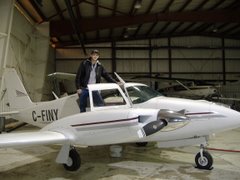Toronto Buttonville. If its not the busiest general aviation airport in Canada I would be surprised. Its my turn to sit left seat in the Navajo, we're returning to home base from Ottawa to fix some more technical issues. We've had a really terrible string of bad luck lately. I've got the ATIS and make my 10 mile call as requested by ATC. (ATIS - Air Traffic Information Service, an automated radio service to tell aircraft pertinent details for departure and arrivals, such as winds, runway in use, etc.).
"Golf Sierra Xray is 10 miles east, 2000 ft."
Its a beautifully calm, blue skied evening and there are at least 4 airplanes doing touch and goes and another 6, including us inbound to land. The controller is making radio calls nearly continuously but still sounds totally calm, maybe even bored. I'm impressed.
"Golf Sierra Xray you're gonna have to pull it right back, right now you're about number 10 for the field. Call me 3 miles out."
Wow poor guy, 10 airplanes and with so little airspace to work with. Two more airplanes report inbound. Make that 12 total.
I pull the two power levers in my hand way back to 23" Manifold Pressure, and we slow down to 120 mph, something a little closer to what a Cessna 172 would be cruising at. Normally we don't slow down this much until we turn onto our final approach to land. I watch the miles tick down as we creep along closer to the airport. I'm anticipating joining the circuit on a right base for runway 33, and both of us in the cockpit have our eyes out side looking for the other 9 airplanes around us. The radio calls are still going rapid fire, and our portable traffic awareness system is also beeping with almost as much frequency.
I make my 3 mile position report. When the radio is this saturated, it can be difficult to jump in and make your required reports without stepping on someone else.
"Golf Sierra Xray turn right to come overhead the field, I'm going to bring you in on a left downwind. You're going to be following a Cessna 172 in the downwind."
I make a shallow right turn to head over the airport instead of setting up for a right base, and we meander our way over top of the field. At 120 mph the controls are no longer the crisp responsive feel that they are at normal cruise speeds. With this much less airflow the airplane feels more like a lumbering beast, and the earth is creeping by in slow motion, but this is a good pace to fit in with the rest of the traffic and gives us enough time to try to spot everyone else up here with us.
We try to find our traffic ahead of us, and I spot a Cessna turning base, but that's a different one than the one we're supposed to be following. The controller is extending everyone's downwind legs to make room for everybody. We're way south of the airport now, heading towards the east of Toronto. We end up turning base, and then final, close in behind a Piper Cheyenne - too close actually. At this spacing he won't have time to clear the runway before we're ready to land. Even though we're still 4 miles back I drop all the flaps and lower the landing gear to slow down even further. I'm riding blue line, 112 mph - the slowest safe speed we can fly. The Cheyenne slowly pulls away from us. It looks like we might be all right, but we still prepare for the possibility of an overshoot if the Cheyenne can't clear the runway in time for us to land. Mixtures rich, propellers to high RPM. We're short final, the Cheyenne is down and turning off the runway just in time. We're cleared to land.
I touch down smoothly in the calm evening air and am stopped in time to exit onto the inactive cross runway. Taxi in, shut down. That was fun!
Subscribe to:
Post Comments (Atom)




Good to know your back writing. Enjoyed the previous two but this was a good one as I enjoy reading the intricacies and challenges of flying. I can recall in the old Cessna being excited about getting to 90 mph or even 100 downwind! Now the earth 'crawls by' at 120.
ReplyDelete